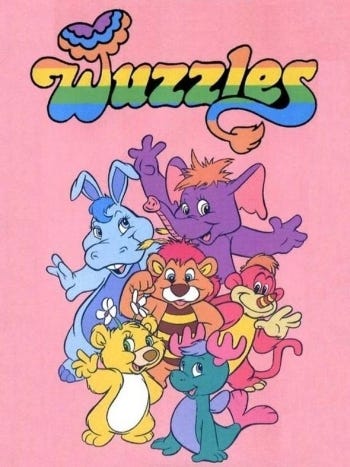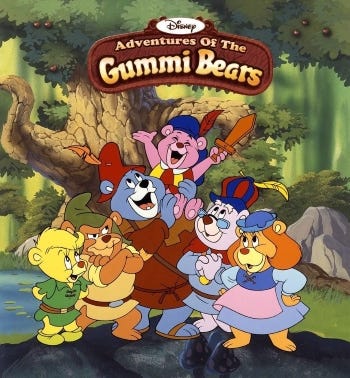Walt Disney was extremely forward-thinking, arguably even a pioneer, when it came to television, getting into the business in 1950. But even with all his work in the field, he didn’t overly concern himself with TV animation. The animation division would produce short pieces and wraparounds for The Mickey Mouse Club or the variously titled anthology series. But Walt believed that the demands of a daily or weekly schedule made animation impractical on television, at least at the level of quality he demanded. The expense would be too great and the theatrical division would suffer.
That changed in the 1980s. For decades, the television landscape had been dominated by cheap, ugly cartoons, especially on Saturday mornings. Incoming CEO Michael Eisner, who wanted to aggressively expand Disney’s reach beyond feature films, saw an opportunity there. If the studio devoted more resources and produced a higher-quality product, it could be a major player in television. After all, they certainly had the expertise and a name brand that was already synonymous with high-quality animation. Plus, they had an entire roster of established and beloved characters.
But to begin with, Disney’s fledgling television animation division was told that Mickey and the rest of the gang were strictly off limits. The board wanted to hedge their bets and protect the studio’s legacy in case this experiment fell flat on its face. Eisner pitched a couple of suggestions, including the idea to develop a series based on a candy that his kids really liked. Hooray for Hollywood, I guess.
On September 14, 1985, Disney’s first two Saturday morning cartoons debuted on competing networks at the exact same time. CBS had The Wuzzles, about a society of cuddly half-and-half animals like Butterbear (half bear, half butterfly).
NBC aired Eisner’s candy commercial, Adventures Of The Gummi Bears. Both shows looked noticeably better than anything else on the air (with the possible exception of the Looney Tunes cartoons still airing on ABC which, of course, had been made decades earlier). But since they were in direct competition with each other, only one could come out on top. The Wuzzles was canceled after a single season but the Gummi Bears stuck around until 1991.
In 1986, the studio decided to try an even bigger gamble. Dipping into their well of iconic characters for the first time, Disney developed a show to be marketed directly to first-run syndication. Traditionally, syndication had been the home of repeats of network cartoons and sitcoms. But original programming for syndication picked up steam in the ‘80s. Disney believed an original animated series could thrive, especially in the afterschool 4-6PM time block. But this meant they’d have to commit to a minimum of 65 episodes right out of the gate. If the show wasn’t a hit, that would be a whole lot of time, energy and money flushed down the drain.
In September of 1987, Disney’s first animated show for syndication finally premiered. DuckTales was based on (or, at the very least, inspired by) the comic book stories of the legendary Carl Barks. Following the treasure-seeking adventures of Scrooge McDuck and his grand-nephews, Huey, Dewey and Louie, the series introduced a wide range of supporting characters, some of which came from the comics and others who were created especially for the show. Honestly, this was a brilliant and long overdue idea for a series. Scrooge had always been severely underused in animation. His biggest showcase to date had been Mickey’s Christmas Carol in 1983. And Barks’ justifiably praised work had just been sitting there for decades, waiting for someone to use it in animation. The show wasn’t a direct adaptation of the comics by any means. But it occasionally got close and helped reintroduce Barks to a new generation.
DuckTales was an immediate hit. Naturally, Disney began to mine the archives for more characters to bring to television. The years that followed saw such shows as Chip ‘n Dale: Rescue Rangers, TaleSpin, Goof Troop and the DuckTales offshoot Darkwing Duck hit the airwaves. DuckTales itself spawned comic books, video games, toys and other assorted merch.
Throughout its run, one of the hallmarks of DuckTales was occasional multi-part sagas that could be aired once as a special and then chopped into five individual episodes for syndicated repeats. While working on season three, producer and director Bob Hathcock had the idea to release one of those epics as a theatrical feature. The problem was that none of the Disney TV shows were actually animated in-house by Walt Disney Feature Animation. The studio had opened a few satellite outposts in places like Florida, London and Paris to handle most of the work and farmed out the rest to other international studios. So DuckTales The Movie couldn’t really be released under the traditional Disney banner.
To solve this dilemma, the studio opened a new division named Disney MovieToons. This gave them the option to release animated films without the expectation that they would feature the same caliber of work as the Disney classics. Eventually, the division would be renamed Disneytoon Studios and pivot to focusing primarily on direct-to-video sequels to movies old and new. A few received a theatrical release and we’ll definitely be seeing those in this column. I might throw in a few of the more interesting DTV titles as well. But DuckTales The Movie: Treasure Of The Lost Lamp inaugurated the studio in theatres.
Now, I’m going to be honest with you. It’s not like I’m some sort of DuckTales super-fan. I was certainly aware of it at the time and it seemed fine. But I don’t have a wealth of knowledge about ancillary characters like Launchpad McQuack, Mrs. Beakley or her granddaughter, Webby Vanderquack. I also couldn’t tell you how Treasure Of The Lost Lamp stacks up compared to your average episode of DuckTales. But as its own thing, it’s not terrible. It certainly isn’t as good as your average Disney animated feature but it’s a cut above most other B or C-list cartoons.
This time out, Uncle Scrooge (voiced, as he had been since 1974, by Alan Young) is on the hunt for the legendary lost treasure of Collie Baba. He locates it buried deep within a great pyramid. But before he can add it to his personal vault and swim around in it, the treasure is stolen by Scrooge’s duplicitous guide, Dijon (the great character actor Richard Libertini), and his evil master, the shape-shifting sorcerer Merlock (Christopher Lloyd, continuing to menace Disney characters after Who Framed Roger Rabbit).
However, the only thing in Collie Baba’s treasure trove that interested Merlock was a magic lamp and, unbeknownst to him, Scrooge already gave that away to Webby because she thought it was pretty and Scrooge assumed it was worthless. Back home in Duckburg, the kids polish up the lamp and discover they’ve freed, what else, a Genie named Gene (nightclub comedian and noted confetti aficionado Rip Taylor). Gene grants the kids three wishes each, resulting in chaos when Webby wishes for her toys to come to life. When Scrooge catches wind of Gene’s power, he wishes for Collie Baba’s treasure and demands Gene accompany him to the Explorers Club’s gala to show off what an awesome treasure hunter he is.
Unfortunately, Dijon and Merlock have stayed on their trail and Scrooge allows the lamp to fall into their hands. Dijon wishes for all of Scrooge’s wealth and power, leaving him penniless. But Merlock has a more sinister agenda, using a magic amulet that grants him unlimited wishes to transform Scrooge’s Money Bin into a flying gothic fortress from which he will rule the world. Will Scrooge and the boys be able to defeat Merlock and restore order to Duckburg? Well, duh.
One of the interesting points about DuckTales The Movie is that the studio’s big brother over at Disney Feature Animation had already been working on Aladdin since 1988. This can be interpreted in a couple of ways. One possibility is that the Movietoons division was so divorced from Feature Animation that they really didn’t notice or care what they were doing. But it also took a long time to get Aladdin to a place where Jeffrey Katzenberg was happy with it. In 1990, there was a decent chance that Aladdin might never get made. If Katzenberg had been more on board with Aladdin from the get-go, he may well have caught wind of the similar movie being made under his nose and tried to put the kibosh on it.
Regardless of how it shook out, Movietoons was allowed to move forward with a theatrical release with hopes of creating an entire series of DuckTales movies. DuckTales The Movie: Treasure Of The Lost Lamp hit theatres on August 3, 1990. A lot of critics barely even noticed it had been released and didn’t bother with it, although it did get a handful of semi-positive reviews. Financially, it didn’t do much better. It opened in eighth place, making just a little bit more than a re-release of The Jungle Book in its fourth week of release (to be fair, The Jungle Book made nearly $45 million on that re-release, making it the 26th highest-grossing film of 1990). It sank quickly, eventually earning just north of $18 million, not enough to cover its budget.
After Treasure Of The Lost Lamp failed to attract an audience, future DuckTales sequels were canceled. The TV show kept on going for another season, airing its last original episode in November of 1990, but continued to air in repeats as part of The Disney Afternoon syndication block. In 2017, the series was rebooted for Disney XD. That version ran until 2021.
The DuckTales movie experiment was not a success but it did help pave the way for Disney’s successful (financially, at least, if not always creatively) focus on direct-to-video fare in the 1990s. And Treasure Of The Lost Lamp continues to have a bit of a cult following among Millennial fans of the show. We’ve probably seen the last of Uncle Scrooge in this column, which is a bit of a shame since a faithful, lavish adaptation of a Carl Barks story like Lost In The Andes might be kind of awesome. But the Movietoons will return eventually, although they won’t be around forever.
VERDICT: I don’t know, it’s harmless and I didn’t hate it. Let’s go with the mildest of Disney Plusses.









I believe you mean Alan Young (not Taylor) as he voiced Scrooge. He was perfect for the role. I was shocked when I learned he was Wilbur on Mr. Ed. He also voiced Farmer Smurf & Scaredy Smurf on Smurfs and probably many other characters